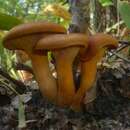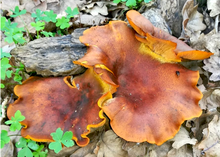en
names in breadcrumbs


The North American Jack O'Lantern mushroom (Omphalotus illudens) has sometimes been treated as conspecific with (i.e., belonging to the same species as) the European O. olearius, but these are now generally recognized as distinct species. Omphalotus illudens, which is also present in Europe, is one of four Omphalotus species that have been described from North and Central America. The widespread eastern North American species is O. illudens and the West Coast one is O. olivascens (O. subilludens occurs in the southeastern United States; Ammirati et al. 1985).
The Jack O'Lantern mushroom's name is derived from the its orange color and the fact that the gills often glow eerily greenish (clearly visible under very dark conditions). This muscarine-containing poisonous mushroom with conspicuously decurrent gills (i.e., gills descending stalk) is widespread and locally common in eastern North America, growing in dense clusters on tree stumps and buried roots of oak and other hardwoods. The spore print is cream-colored.
(Lincoff 1981; Arora 1986; Kirchmair et al. 2004 and references therein)
Omphalotus olearius,[2] commonly known as the jack-o'-lantern mushroom, is a poisonous orange gilled mushroom that to an untrained eye appears similar to some chanterelles. It is notable for its bioluminescent properties. It is found in woodland areas in Europe, where it grows on decaying stumps, on buried roots or at the base of hardwood trees. It has also been reported from the Western Cape Province, South Africa. A similar, but phylogenetically distinct[3] species found in eastern North America is Omphalotus illudens.
Unlike chanterelles, Omphalotus olearius and other Omphalotus species contain the toxin illudin S, and are poisonous to humans. While not lethal, consuming this mushroom leads to very severe cramps, vomiting, and diarrhea.
The jack-o'-lantern mushroom is orange. Its bioluminescence, a blue-green color, can be observed in fresh specimens in low light conditions once the eye becomes dark-adapted. The whole mushroom does not glow—only the gills do so. This is due to an enzyme called luciferase, acting upon a compound called luciferin, leading to the emission of light much as fireflies do when glowing.[4]
Unlike chanterelles, jack-o'-lantern mushrooms have true, sharp, non-forking gills; this is possibly the simplest trait for distinguishing between the two. Furthermore, if the jack-o'-lantern's stem is peeled, the inside is orange, while the chanterelle is paler inside the stem.
Omphalotus illudens of eastern North America, and the Western jack-o'-lantern mushroom Omphalotus olivascens common in southern to central California, are both poisonous. The similarly poisonous mushroom Tsukiyotake (Omphalotus japonicus, formerly known as Lampteromyces japonicus, found in Japan and eastern Asia, is also bioluminescent and contains the same poison, illudin.[3]
 Omphalotus olearus from South Africa
Omphalotus olearus from South Africa Omphalotus olearius, commonly known as the jack-o'-lantern mushroom, is a poisonous orange gilled mushroom that to an untrained eye appears similar to some chanterelles. It is notable for its bioluminescent properties. It is found in woodland areas in Europe, where it grows on decaying stumps, on buried roots or at the base of hardwood trees. It has also been reported from the Western Cape Province, South Africa. A similar, but phylogenetically distinct species found in eastern North America is Omphalotus illudens.
Unlike chanterelles, Omphalotus olearius and other Omphalotus species contain the toxin illudin S, and are poisonous to humans. While not lethal, consuming this mushroom leads to very severe cramps, vomiting, and diarrhea.